- You are here:
- Home »
- Author's archive:
All posts by Bike Master
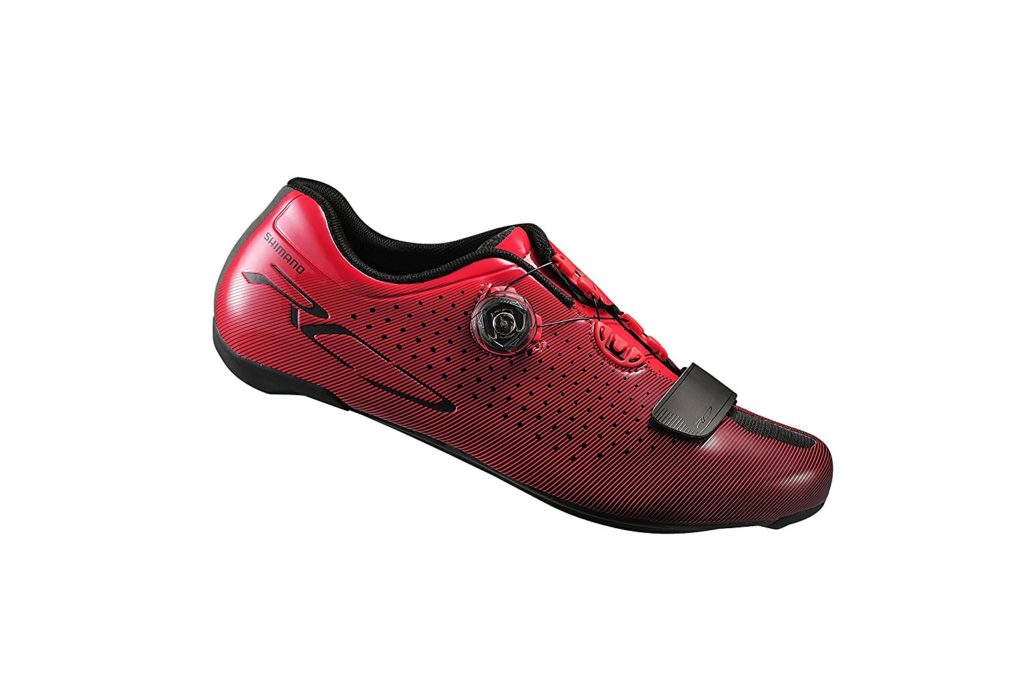
Best Cycling Shoes for Men and Women of 2017
The gear that one uses makes all the difference for those who make a lifestyle choice out of biking. Cardiovascular endurance puts a heavy strain on many parts of the body and, most of all, the feet and legs. The best cycling shoes for men and women of 2017 are designed to protect the rider’s joints and muscles from strain and long-term damage, as well as to enable the most efficient riding.
Cycling Shoe Key Features
Just like cycling shorts, a pair of shoes made for cycling come in many shapes and sizes and are made for indoor, outdoor, or off-trail biking. It is important to take special note of how the shoe feels on your foot as not all cycling shoes are made for all feet—there is no such thing as ‘no one shoe fits all.’ Consider finding a few of the best cycling shoes that you would like to try on and go to your local bike shop to give them a try.
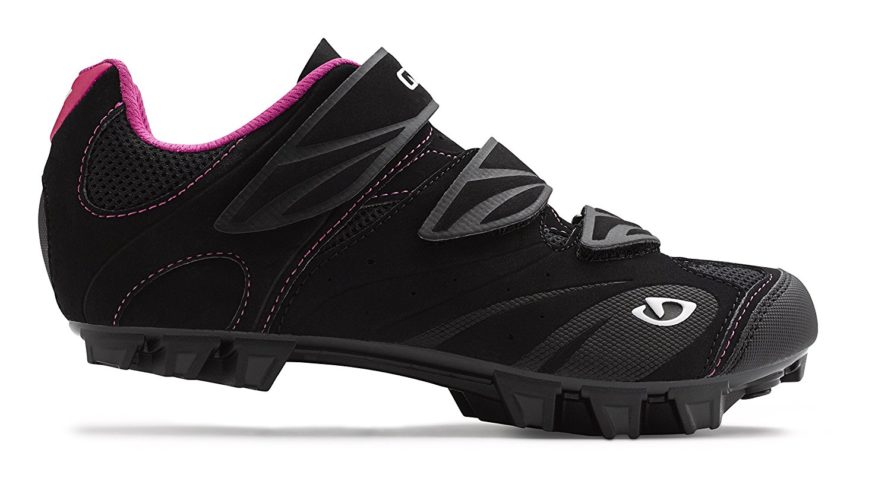 Once you are ready to settle on one pair that feels good and fits well, save some money by ordering them from our links below. Of the many design aspects present, there are four key features that bikers should take note of when looking at cycling shoes.
Once you are ready to settle on one pair that feels good and fits well, save some money by ordering them from our links below. Of the many design aspects present, there are four key features that bikers should take note of when looking at cycling shoes.
Fasteners
Cycling shoes feature one of four different fastening methods. The most common and inexpensive fasteners are made by Velcro. Velcro can be easy to adjust and lightweight but will lose strength over time with continued rugged use. There are some cycling shoes that feature laces, but these are specialized and can be quite pricey. The highest quality systems include Ratchets and Boa Dials.
The Ratchet system is secure and accurate but it is quite impossible to adjust during a ride. The Boa Dial system is not cheap, but it gives cyclists the best of both worlds, with a lightweight design that is easy to adjust mid-ride and provides the most secure fit.
Soles
Cycling shoes will most often feature a hard sole design, which supports the foot as a whole when hooked into small pedals. The soles are usually constructed out of carbon, plastic, or a combination of both. Carbon fiber is the best quality material for cycling shoe soles, due to its stiff design and lightweight; however, carbon soles are often seen in shoes that sit on the upper end of the price scale.
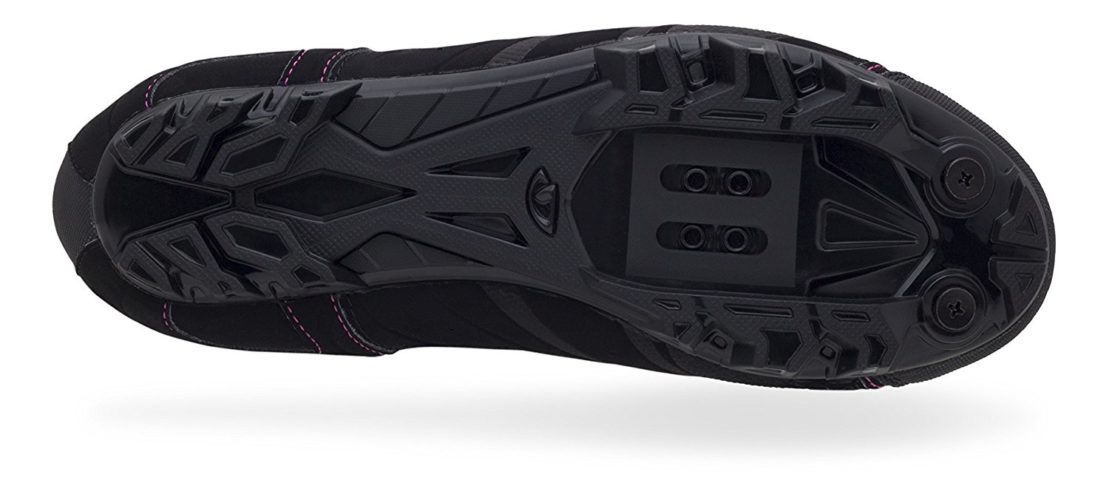 Plastic soles are much more affordable; however, their durability and overall quality is not that of longevity. Cycling shoes in the middle of the market range are often constructed of a composite combination of carbon and plastic. Try on several pairs with different sole construction to determine the sole stiffness that feels best for you.
Plastic soles are much more affordable; however, their durability and overall quality is not that of longevity. Cycling shoes in the middle of the market range are often constructed of a composite combination of carbon and plastic. Try on several pairs with different sole construction to determine the sole stiffness that feels best for you.
Cleat Design
Cleats are designed as either 2-bolt SPD clipless cleats or 3-bolt cleats. 3-bolt cleats are sometimes preferred by those whose main form of cycling is indoor spin cycling. They are very secure to the pedals but are not easy to walk in. Clipless cleats with 2 bolts are often preferred by bike commuters and touring cyclists riding outdoors.
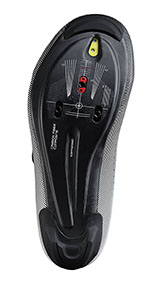 This is because clipless pedals allow the rider to remove their foot from the pedal at any time, simply by swinging their heel away from the bike. 2-bolt SPD cleats are also designed to sit inside of the cycling shoe, making it easy and comfortable to walk in them. Try cycling with both styles before settling on one or the other.
This is because clipless pedals allow the rider to remove their foot from the pedal at any time, simply by swinging their heel away from the bike. 2-bolt SPD cleats are also designed to sit inside of the cycling shoe, making it easy and comfortable to walk in them. Try cycling with both styles before settling on one or the other.
Fit and Comfort
The make and model of cycling shoe that you choose will determine how the shoe fits. Many brands are designed with a different standard for width and snugness of the cycling shoe, which will determine how comfortable it is to ride over the long term.
In general, bikers with narrow feet will be served better by Specialized, Giro, and Fizik, whereas Shimano and Bont design cycling shoes with wider feet in mind. Once again, try before you buy as the fit of your shoe will determine how comfortable it is to ride with.
Best Cycling Shoes of 2017
The market is saturated with biking shoes of all types and wading through the options can be an arduous task. We consider the best cycling shoe for men and women to be one that is not only designed with exceptional quality features but also at an affordable price. Below, you will find our top cycling shoe picks for men and women, in 2017.
Best Cycling Shoes for Men
1. Shimano RC7 Lightweight Road Cycling Shoe
Shimano creates some of the best quality biking gear and hardware available on the market. The SH-RC7 is our pick for the best mid-range cycling shoe for men of 2017. Coming in around $180, these cycling shoes are high quality, yet affordable.
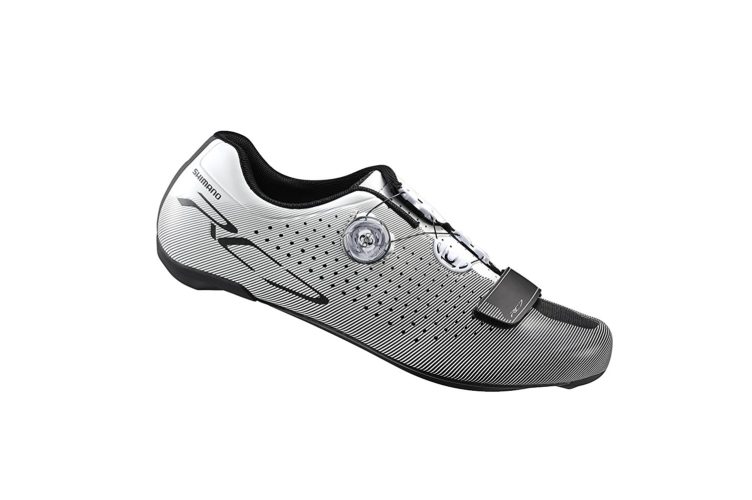 Description and Features
Description and Features
The SH-RC7 tends to be a bit wider than others made for men with large feet. Designed for road racing and endurance cycling, the SH-RC7 features a carbon composite sole for the most support on the pedals. These shoes are lightweight and fashioned from a perforated synthetic leather blend, which is breathable, strong, and soft.
Shimano designed the SH-RC7 with a Boa IP1 reel strap fastening system, which distributes pressure evenly across the top of a rider’s foot, where other designs may constrict circulation to the foot. The hook and loop fastener strap provides a full range of adjustability, allowing the fit to be customized for a wide range of feet.
This cycling shoe has a stiffness rating of 10 out of 12. The hard sole carbon composite provides a maximum amount of support for a rider’s foot, which results in more power and less wasted effort. The SH-RC7 is designed to accommodate a 3-bolt locking system, which makes it perfect for indoor spinning and outdoor long-distance riding.
Best Cycling Shoes for Women of 2017
2. Sidi Level Carbon Road Cycling Shoe
Sidi has been providing the professional biking industry with top quality equipment and gear since 1960. However, their Level product line is specifically designed for entry-level riders, who are serious about cycling.
Due to the overwhelmingly positive reputation of the brand and a reasonable price tag coming in around $140, the Sidi Level Carbon is our pick for the best cycling shoe for women of 2017.
Description and Features
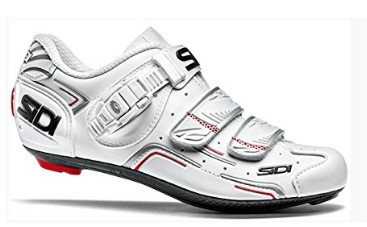 The Sidi Level is built with a Millennium carbon sole and a buckle closure system. The buckle is operated by a lever on the top of the shoe, which releases or adds tension.
The Sidi Level is built with a Millennium carbon sole and a buckle closure system. The buckle is operated by a lever on the top of the shoe, which releases or adds tension.
To completely release tension, the rider squeezes both ends of the buckle, which unhooks the fasteners. Sidi’s buckle closure system makes it easy and safe to adjust your cycling shoe tension while in motion.
The Sidi Level provides a substantial step up from the traditional nylon sole. The Sidi Level features a nylon/carbon injected matrix fiber, which lets the shoe retain its structure and rigidity, even through heavy temperature changes. The material is inherently water-repellent and is unaffected by changes in the environment’s humidity. The sole is drilled with a 3-hole cleat design; however, it is completely compatible with most standard clipless and 3-hole cleats, allowing for a maximum level of versatility for outdoor or indoor usage.
The carbon sole works in conjunction with the shoe’s heel cup, which retains its shape through heavy use and prolonged riding. The cup is anatomically designed to keep the rider’s heel from slipping, which provides additional protection in the event of an accident and the Sidi Level includes a spare polyurethane heel pad.
More Options
For those who are looking for a more advanced or even an entry-level shoe, check out our other top cycling shoe picks for 2017.
● Giro Riela R Trail Shoe
● Louis Garneau Multi Air Flex Fitness and Mountain Bike Shoe
● Diadora Trivex Plus II Cycling Shoe
● Pearl Izumi Tri Fly V
Feel free to leave comments and questions and always remember to wear a helmet!
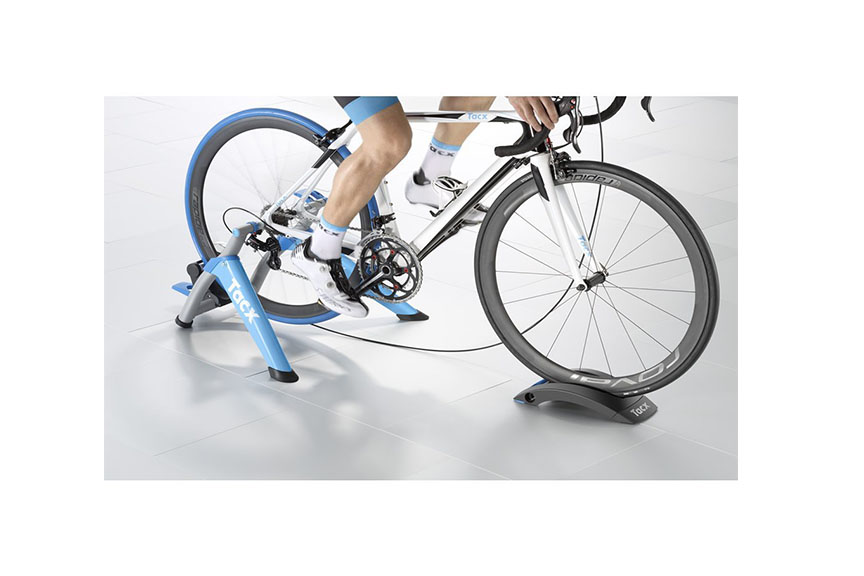
Smart Turbo Trainer Review
Like real wheel, neo smart, and fluid trainers, smart turbo trainers are a great tool for cyclists and their bikes for a great workout in order to maintain their conditioning in the cold winter months and to prepare for races or cross-country tours. In recent years, leading Cycleops, Cadence Sensor, and Elite Supercrono have created brand names like turbo cycle trainers have undergone a major innovative shift with the integration of smart technology.
Smart turbo trainers make cycle training with bikes more fun, engaging, and convenient for bikers all over the world. This smart turbo trainer review is designed to educate bikers on the added benefits of use, as well as the top products on the market.
Turbo trainers are the elite method of a good workout for cyclists. They are small, reliable, and convenient to use in one’s home. The design of a traditional trainer implements a stand for the back wheel, which connects into an adjustable resistance unit. Riders can change the resistance based on their training regiment and moment-to-moment needs.
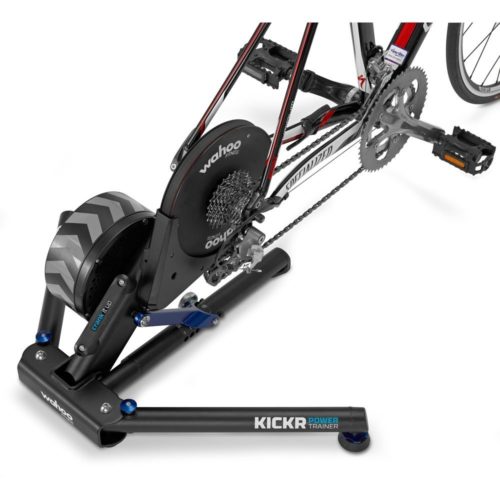 The designs of these units are mainly mechanical in nature, and therefore, require the user to stop riding in order to adjust the unit’s settings. Smart turbo trainers, maintain the design integrity of the best turbo trainers and implement a wide range of smart technology capabilities, benefiting the user in numerous ways.
The designs of these units are mainly mechanical in nature, and therefore, require the user to stop riding in order to adjust the unit’s settings. Smart turbo trainers, maintain the design integrity of the best turbo trainers and implement a wide range of smart technology capabilities, benefiting the user in numerous ways.
What is a Smart Turbo Trainer?
A smart turbo trainer is essentially a turbo trainer—but better. These elite trainers are designed for cyclists to engage in a fully-focused training session, using their own bike from the location of their choosing, just like a traditional turbo trainer.
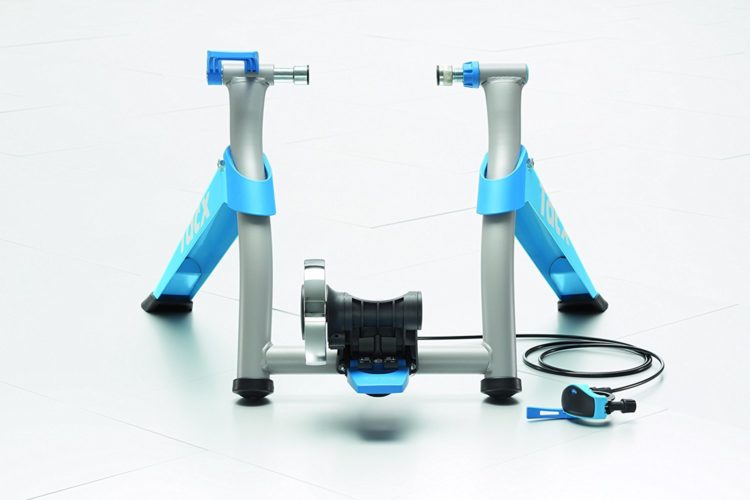 However, smart turbo trainers perform a range of additional functions to work out resistance levels and many other things, from sending stats on your session to your computer or mobile device to enabling virtual community training features with other riders all over the world. Smart trainers are, generally, sorted into two categories…
However, smart turbo trainers perform a range of additional functions to work out resistance levels and many other things, from sending stats on your session to your computer or mobile device to enabling virtual community training features with other riders all over the world. Smart trainers are, generally, sorted into two categories…
Half-Smart Turbo Trainers
Half-smart turbo trainers are designed with wireless electronic communication ability and sensors which measure speed, distance, and other general specs. These units are able to send this information directly to the user’s phone, computer and tablet automatically.
These units are excellent for bikers who are new to turbo trainers, but they lack the sophistication and convenience features of a fully smart unit.
Fully Smart Turbo Trainers
A fully smart turbo trainer will change the way you train and how much you enjoy doing it. Users have complete control of the smart turbo trainer from a downloadable mobile app, allowing them to control the unit remotely. With a smart turbo trainer, you can raise and lower the unit’s resistance with the click of a button, as well as engage with other real riders.
The best smart turbo trainers are designed with ANT+FE-C capabilities, which allows for the user to track their speed, heart rate, and power output, as well as to interface with the units control settings. Cyclists can even connect up with other riders online to race or cruise together, using apps such as Zwift.
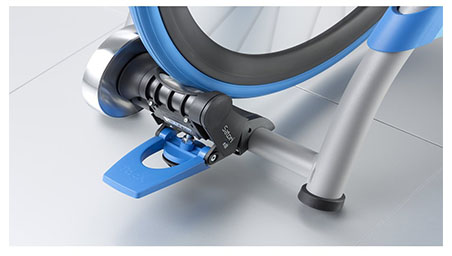 Smart Turbo Trainers combine the best elements of cycling and virtual gaming to make your indoor training much more productive and enjoyable. Fully smart trainers have the ability to link up with a piece of software, which will tell the trainer when to change the resistance and by how much, automatically.
Smart Turbo Trainers combine the best elements of cycling and virtual gaming to make your indoor training much more productive and enjoyable. Fully smart trainers have the ability to link up with a piece of software, which will tell the trainer when to change the resistance and by how much, automatically.
Combined with Zwift, riders can hook it up to their TV and be able to see the course on which they are riding, just as in real life. The resistance varies in conjunction with the terrain of the course, providing an incredibly realistic and satisfying experience.
Smart Turbo Trainer Review
To take advantage of all that a smart turbo trainer has to offer, you will want a mount on your bicycle’s handlebars to hold your phone or tablet. If you are using a laptop, it is recommended that you have a laptop tray that stands tall enough to easily reach from a seated riding position on your bike.
In this way, your smart turbo trainers will give you the most convenience and functionality during your ride. This smart turbo trainer review will give you a reference point on some of the best products available.
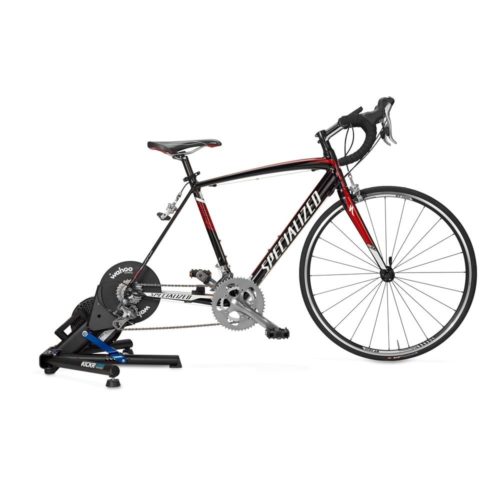 1. Wahoo KICKR smart trainer
1. Wahoo KICKR smart trainer
We chose the Wahoo KICKR smart trainer, as the best smart turbo trainer reviewed overall. This trainer is the top of the line and features all of the bells and whistles that a rider could ask for.
The Wahoo KICKR is great for cyclists who want a trainer that accurately simulates the sensation of riding on the road.
Design and Features
The Wahoo KICKR provides the user with a state of the art, customizable, unique cycle training experience. This smart trainer is designed to measure the rider’s power output straight from the hub, which is a uniquely individual product feature of this unit. The user can control the KICKR smart trainer from their iDevice, Mac book laptop, Windows PC, or tablet.
The Wahoo KICKR implements a “wheel-off” design, which attaches the user’s bike to the trainer through a direct-drive system. This eliminates the added wear on your tire, as well as maintains an accurate power reading.
It features Bluetooth 4.0 compatibility and is perfect for linking up with virtual bike trainer accounts, such as Zwift. Coming in around $1300, the Wahoo KICKR is made for serious cyclists who appreciate master craftsmanship.
2. Tacx Satori Smart turbo trainer
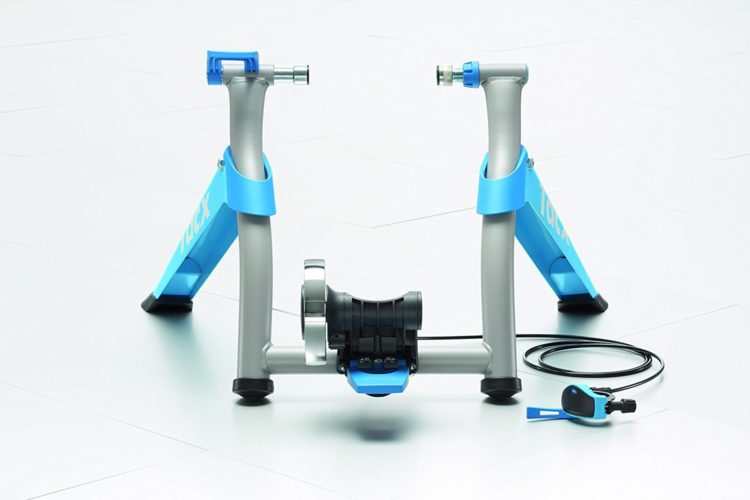 For those who are serious about training, but are interested in a lower price bracket, the Tacx Satori Smart turbo trainers come in around $400 to $500.
For those who are serious about training, but are interested in a lower price bracket, the Tacx Satori Smart turbo trainers come in around $400 to $500.
Less than half the price of the Wahoo KICKR, the Tacx Satori delivers all of the required features expected from a smart turbo trainer, plus more. This is the best smart turbo trainer for heavy-duty cyclists on a budget.
Design and Features
Designed with a magnetic resistance drive, the Tacx Satori features 10 levels of resistance. This unit is Bluetooth enabled and communicates with all computer and mobile platforms, including Mac, Windows, Android, and iDevices.
Users can sync their wearable smart technology, such as heart rate monitors and smartwatches with the trainer to incorporate as much user data as possible. Although this unit does not feature an automatic resistance control, the manually controlled magnetic resistance handle is easily accessible while sitting on the bike.
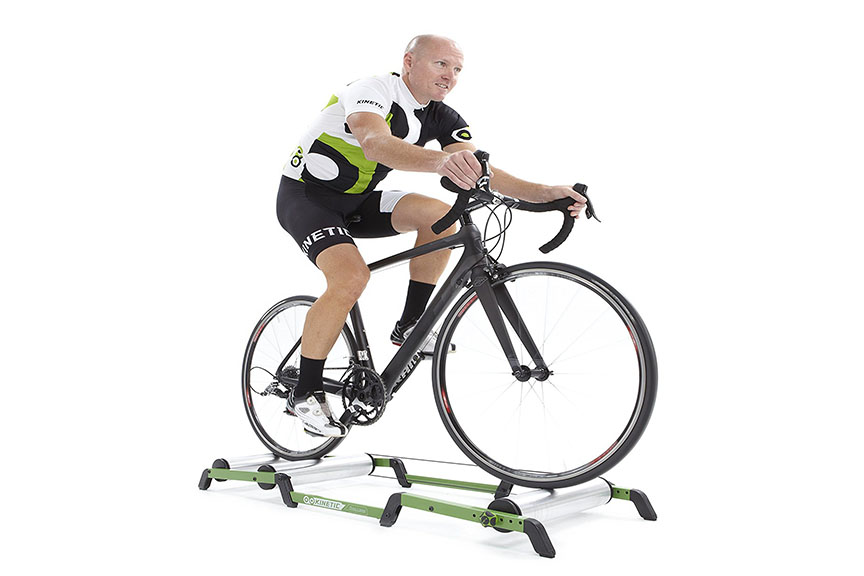
Best Kinetic Brand Bike Trainers
Kinetic is an industry leader in the bicycle trainer market. Their product line of turbo trainers and smart turbo trainers are among the highest quality in the industry. Here, we will take a look at the many optional features that a bicycle trainer may include, as well as the best kinetic brand bike trainers on the market.
Key Bike Trainer Specs
All bikes are not created equally, nor are their riders. Some enjoy trail riding and mountain biking, while others stick to the streets and cross-country roads. Luckily, Kinetic offers bike trainers for every type of rider and every bike classification. Before you go shopping for the perfect indoor trainer, it is beneficial to predetermine the features that will be most useful for your training needs.
Performance and Adjustability
Trainers operate by creating resistance to your bike’s drive train. The way in which the resistance is created can vary from model to model and there are several ways of doing so.
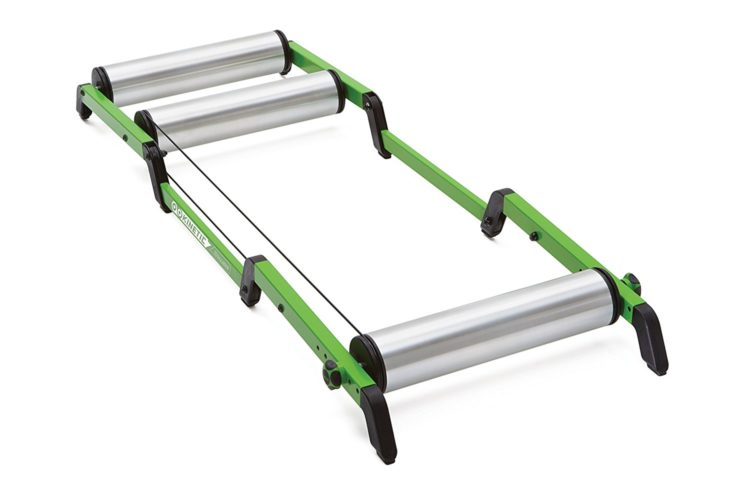 Most turbo trainers are designed with an adjustable resistance feature, which is operated either by hand or electronically. However, roller trainers, like the Kinetic Z Rollers, do not feature adjustable resistance and are meant for riders to just hop on and go, go, go.
Most turbo trainers are designed with an adjustable resistance feature, which is operated either by hand or electronically. However, roller trainers, like the Kinetic Z Rollers, do not feature adjustable resistance and are meant for riders to just hop on and go, go, go.
Convenience, Storage, and Ease
Trainers, like the Kinetic Road Machine Smart Control Trainer, are designed for your bike’s back wheel to attach to the machine, without removing the wheel. Others models may be designed for those who do not plan on transporting their trainer very often, as they require the cyclist to remove the back wheel of their bike and attach the drive train directly to the trainer.
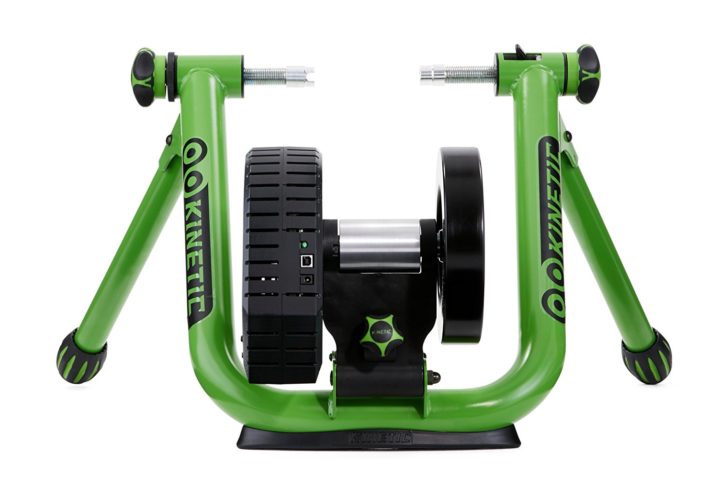 These models are useful, in mitigating the wear and tear on your bicycle’s rear tire; however, it is a bit more involved to get your bike street ready at a moment’s notice. Some trainers are a bit deceiving in size, such as the Kinetic Z Rollers. At full length, the unit is slightly larger than your bicycle; however, this purely mechanical trainer is designed to fold three times for easy storage and transportation.
These models are useful, in mitigating the wear and tear on your bicycle’s rear tire; however, it is a bit more involved to get your bike street ready at a moment’s notice. Some trainers are a bit deceiving in size, such as the Kinetic Z Rollers. At full length, the unit is slightly larger than your bicycle; however, this purely mechanical trainer is designed to fold three times for easy storage and transportation.
Sound Obstruction and Price Difference
Remember the old 1970’s era gymnasium cycle trainers, which had the big fans? That design is definitely still in use. It is cheap and reliable, but noisy! If you are used to putting in your headphones and jamming out while biking, this might not be a problem. However, many cyclists do not enjoy the noise created by wind trainers and, luckily, they are no longer the only option for indoor bike training.
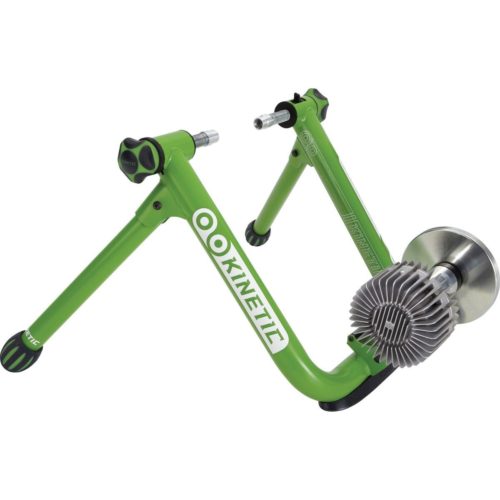 The Kinetic Road Machine 2.0 Fluid Trainer implements a fluid resistance design, along with a magnetic drive train, which is both very quiet and extremely accurate. The fluid flywheel and the magnetic train work in tandem to keep all moving parts of the trainer in synchronized unison. With added features that improve performance and noise control, comes a higher price tag; however, the improved resistance technology of these units also benefits the user, due to the mitigation of ongoing maintenance.
The Kinetic Road Machine 2.0 Fluid Trainer implements a fluid resistance design, along with a magnetic drive train, which is both very quiet and extremely accurate. The fluid flywheel and the magnetic train work in tandem to keep all moving parts of the trainer in synchronized unison. With added features that improve performance and noise control, comes a higher price tag; however, the improved resistance technology of these units also benefits the user, due to the mitigation of ongoing maintenance.
Types of Kinetic Bike Trainers
Although a wind trainer is a classic, most recognizable design, Kinetic has graduated to a higher level of craftsmanship. However, they still offer the Trainer Wind Cyclone, which is one of the best wind trainers on the market. They seek to provide reliable, durable, and maintenance-free bike trainers for a wide range of bikers.
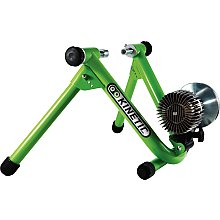 Beginners might be alright with a wind trainer; however, cyclists quickly outgrow these bare bones models and yearn for something a bit more substantial and versatile. The Kinetic brand offers high-quality bike trainers, designed with cutting-edge manufacturing technologies and design methodologies.
Beginners might be alright with a wind trainer; however, cyclists quickly outgrow these bare bones models and yearn for something a bit more substantial and versatile. The Kinetic brand offers high-quality bike trainers, designed with cutting-edge manufacturing technologies and design methodologies.
Magnetic Resistance Bike Trainer
Most of Kinetics bike trainers are built with a fluid resistance system, as is the Kinetic Road Machine 2.0 Fluid Trainer. However, this unit also incorporates a magnetic train to the flywheel. Magnetic resistance is progressive, constant, and very satisfying to ride with, as it simulates a smooth pavement feeling.
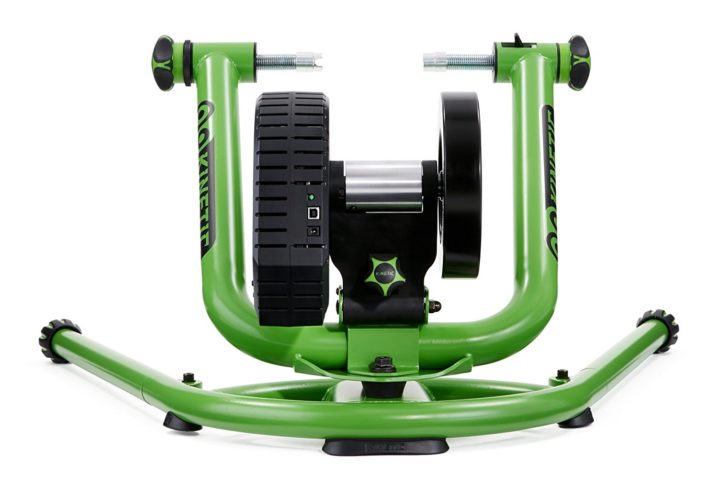 Smart trainers, such as the Kinetic Rock and Roll Smart Control Bike Trainer, operate an electromagnetic resistance wheel, which is controlled remotely via Bluetooth compatibility. The best part of magnetic trainers is the sound reduction from traditional wind trainers. The magnets are silent and the only sound made is that of the rider pedaling away. Magnetic trainers offer variable resistance, via a hand switch or a remote control.
Smart trainers, such as the Kinetic Rock and Roll Smart Control Bike Trainer, operate an electromagnetic resistance wheel, which is controlled remotely via Bluetooth compatibility. The best part of magnetic trainers is the sound reduction from traditional wind trainers. The magnets are silent and the only sound made is that of the rider pedaling away. Magnetic trainers offer variable resistance, via a hand switch or a remote control.
Fluid Resistance Bike Trainer
All fluid resistance bike trainers are based on the classic magnetic flywheel design. On top of the variability offered by the magnets, the fluid design gives riders the ability to fine tune their resistance, in a consistent and progressive nature. Fluid trainers are the best for those who want to feel like they are riding on a smooth road.
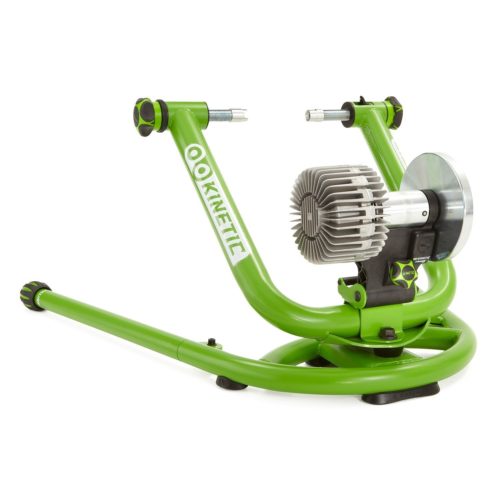 Models, such as the Kinetic Rock and Roll Smart Bike Trainer and the Kinetic Road Machine Smart Control Trainer can be fine tuned remotely from the user’s smartphone or tablet.
Models, such as the Kinetic Rock and Roll Smart Bike Trainer and the Kinetic Road Machine Smart Control Trainer can be fine tuned remotely from the user’s smartphone or tablet.
Roller Trainers
The Kinetic Z Rollers are Kinetic’s tribute to the original bike trainer. Simply designed, durable, and hassle free, these models are made for easy use and easy storage. Your bike sits atop a set of 3 precision roller drums—one on the front wheel and 2 that cradle the rear wheel. The bike simply rolls under its own power, without the use of any additional resistance.
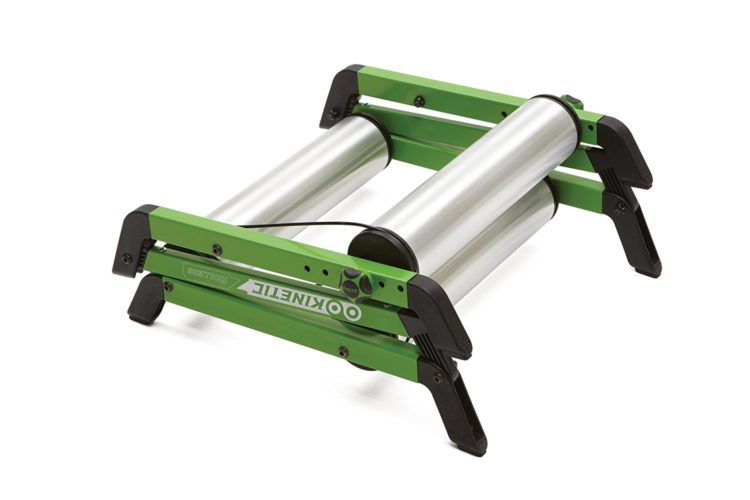 Though Kinetic has not integrated any smart technology, remote capabilities or fancy fluid resistance into the Kinetic Z Rollers, it is still one of the best rolling trainers on the market, thanks to Kinetic’s uncompromised attention to detail, quality, and durability. The Kinetic Z Roller is also one of the best bike trainers for those on a budget, as it comes in around $300.
Though Kinetic has not integrated any smart technology, remote capabilities or fancy fluid resistance into the Kinetic Z Rollers, it is still one of the best rolling trainers on the market, thanks to Kinetic’s uncompromised attention to detail, quality, and durability. The Kinetic Z Roller is also one of the best bike trainers for those on a budget, as it comes in around $300.
A bike trainer will take your cycling and conditioning to the next level and provide the ease and convenience to make cycling a part of your daily life. When looking for the best brand of bike trainers, if you do not want to sacrifice design integrity for frugality, go with Kinetic. The best Kinetic Bike trainers are made for the best bikers, so up your game this season with a Kinetic trainer.
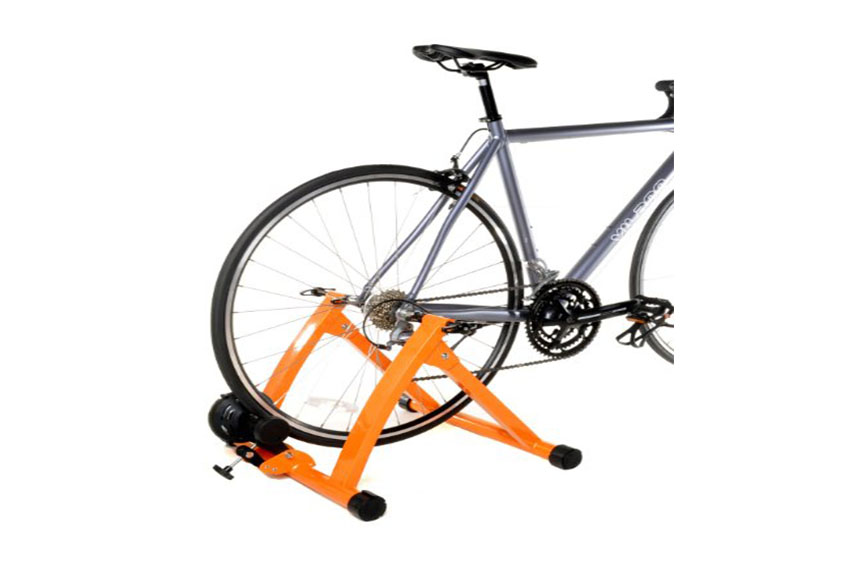
Why You Should Have an Indoor Bike Stand
Summer is almost here and you know what that means—bike weather! That’s right. It’s time to dust off your set of wheels and take to the streets. Of course, you are prepared to acclimatize your buns to the feel of the saddle and you’re not looking forward to how your legs are going to feel in the morning.
Nevertheless, you are determined to really give it your all this year. However, biking does not have to be a fair weather activity. Many avid bikers continue their conditioning all through the winter months by using an indoor stationary bike stand.
So, before you take the cycle out for its first cruise of the season, only to abandon it once again to the depths of the garage while you ice your sore buns for the next week, consider the reasons why you should have an indoor bike stand.
It all comes down to consistency. Riding for fun is great, but the biggest benefits of biking are experienced when you make a concerted effort to change the way in which you commute.
 Biking on a regular basis improves your cardiovascular health, muscle strength, endurance stamina, and overall feeling of wellbeing—not to mention the substantial financial savings that become immediately evident, regarding gasoline expenditure, vehicle maintenance, and extraneous costs for parking and more. Biking is, by far, the most health and cost efficient way of commuting.
Biking on a regular basis improves your cardiovascular health, muscle strength, endurance stamina, and overall feeling of wellbeing—not to mention the substantial financial savings that become immediately evident, regarding gasoline expenditure, vehicle maintenance, and extraneous costs for parking and more. Biking is, by far, the most health and cost efficient way of commuting.
Once you establish a habit of bike commuting, it becomes the part of your day that you look forward to. Your body feels alive and invigorated all through the day and you wake up with the anticipation of an exhilarating commute. There is one catch, however, that becomes one of the biggest deterrents to prospective bike commuters—discomfort.
Consistency is Key
There simply is no substitute for regularity and conditioning. The joy of regular biking is mitigated for those who do not engage in it on an everyday basis. This is because their body never gets into the rhythm of daily physical activity, as well as the soreness that results in the riders physical contact points on the bike. Let’s look at another example, which will illustrate this logic…
No Pain, No Gain
Imagine someone who is taking their first guitar lesson and we can call this person, Jill. Jill is excited to learn how to play guitar and she’s not afraid of hard work and focus, but Jill has never been big on physical discomfort. To Jill’s dismay, one of the first obstacles in studying the guitar is to form calluses on her fingers. Before she does this, it will be very difficult to improve as calluses will form naturally to shield her fingers nerve ending from the acute pressure of the guitar strings.
 Since it hurts her fingers to practice, Jill never gets to actually learn how to play the guitar, because she never got over the physical learning curve. Jill’s teacher gives her a little gizmo to strengthen her hand, which will help to condition the muscles that she will use for playing. After a few weeks of strengthening her hand and finger muscles, she is able to maintain a regular practicing regiment, which results in her fingers becoming calloused and her ability to improve becomes exponentially easier, especially with a stationary bike stand.
Since it hurts her fingers to practice, Jill never gets to actually learn how to play the guitar, because she never got over the physical learning curve. Jill’s teacher gives her a little gizmo to strengthen her hand, which will help to condition the muscles that she will use for playing. After a few weeks of strengthening her hand and finger muscles, she is able to maintain a regular practicing regiment, which results in her fingers becoming calloused and her ability to improve becomes exponentially easier, especially with a stationary bike stand.
There is an exact equivalent for bikers and indoor cycling, in the way in which one’s body acclimates to the pressure points of one’s bike, as well as in the conditioning to be maintained using an indoor bike stand trainer. Even if you can’t take the bike out on the town every day, you can keep up your physical conditioning by using a bicycle trainer stand in the comfort of your own home or at the gym.
Without regularity and consistency, the human body wants to find a natural stasis or neutral mode. This is why enabling your daily routine to accommodate cycle conditioning is essential. By keeping up with your biking, either outdoors or indoors, your body will settle into an active neutral state and will stay in a place of readiness from day to day, instead of losing the progress which you have made with indoor cycling.
Why You Should Have an Indoor Bike Stand
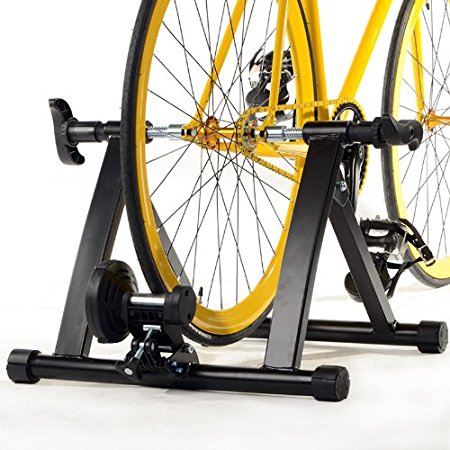 Indoor bike stands, or bicycle trainers, are an essential piece of gear for the serious biker or cardio enthusiast. No matter your daily routine, a bike trainer allows cyclists to use their trainers in their homes, office, school, local gym, or anywhere else that has just enough space to fit their bike.
Indoor bike stands, or bicycle trainers, are an essential piece of gear for the serious biker or cardio enthusiast. No matter your daily routine, a bike trainer allows cyclists to use their trainers in their homes, office, school, local gym, or anywhere else that has just enough space to fit their bike.
Bike stand trainers offer many benefits for those looking to improve the quality of their health and biking performance with a concise, convenient method.
Key Benefits
● Maintain a Healthy Routine in Any Weather
No matter which weather has decided to show up, you never have to sacrifice your daily ride due to nature. With an essential bike trainer indoors, bikers are empowered to maintain their physical conditioning without having to purchase extensive amounts of weather specific gear, which can incur ongoing costs to maintain and replace worn out equipment.
An indoor bike trainer is a one-time expense, which can range between $50 and $1500, depending on the features that you require.
● Train on Your Own Wheels
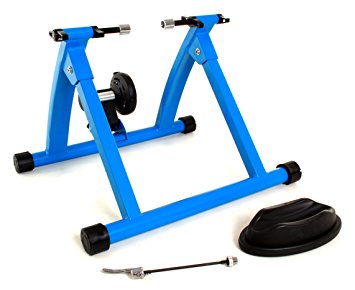 Unlike a stationary spinning machine or other exercise bike often found in herds at your local gym, a bike trainer allows you to use the same bike that you use on the road.
Unlike a stationary spinning machine or other exercise bike often found in herds at your local gym, a bike trainer allows you to use the same bike that you use on the road.
Indoor bike stands will attach either to the back wheel of your bike or the back drive train—without the wheel. This is a huge plus for bikers who use cycling shoes of a clip-on, or clipless design, as it allows you to train with your own gear and equipment.
● Take Your Trainer on the Go
Indoor bike trainer stands usually weigh between 40 to 60 pounds and come in convenient carrying cases. They are designed to be portable and mobile, many models including a wheeled case to transport them. Even the larger roller trainers and exercise bikes are foldable and designed for wheeled transportation.
● Have Fun with Other Riders Abroad
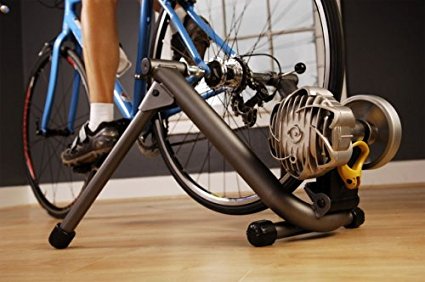 Trainers have seen some great innovations recently with the advent of Smart Turbo Trainers. These indoor bike stands are designed with wireless capabilities and remote controlled operations.
Trainers have seen some great innovations recently with the advent of Smart Turbo Trainers. These indoor bike stands are designed with wireless capabilities and remote controlled operations.
By logging into trainer software, such as Zwift, CycleOps, or TrainerRoad, cyclists can link up with other real people from across the globe, to race on a variety of different courses. The smart technology allows the map to communicate with your trainer, automatically shifting the resistance to correspond with the terrain of your virtual route.
Whether you are a new biker or a veteran, an indoor bike stand trainer will accelerate your rate of improvement and overall health. Why you should have an indoor bike stand, has to do with self-betterment and unlocking your optimum potential as a cyclist. Best of all, no helmet is required.
Feel free to leave comments and questions and thanks for reading!
